
Micro-fulfilment centres are much smaller than warehouses, which typically need to be on the outskirts of cities. Instead, micro-fulfilment centres are compact and can be set up within cities, ensuring quicker service to a large segment of customers
In addition to the low cost per square metre, these types of robotic fulfilment centres significantly boost operational efficiency. They also need only a handful of employees at a time. An operator at a counter - one of just four "touchpoints" - assembles incoming orders from arriving bins, picks the items from them, then scans and bags them. Bags are lowered and robotically ferried to a second touchpoint, an outbound terminal.
Operated by robots and usually smaller than 1,000 square metres, micro fulfilment centres are emerging as the future of last-mile delivery logistics. The strategy, operated through software and executed via automation, powers the strategy known as micro fulfilment. It is aimed at speeding up the delivery of goods to consumers in cities through operations that pack large numbers of products into tight, urban spaces.
Far smaller than the typical big-box distribution centres found in most industrial parks, the sites are becoming increasingly attractive to retailers adjusting to the changes in consumer markets. Some have been testing these types of small fulfilment sites in recent years, but the rush to online shopping thanks to Covid-19 pandemic has accelerated moves to space-saving, automation-powered warehouses.
By squeezing those operations into small urban warehouses, businesses hope to pare down delivery times so online orders reach their destination in hours, not days. Companies storing goods at micro-fulfilment sites should be able to get orders picked and packed in five minutes or less, with only a handful of workers.
Most micro-fulfilment operations are still being tested, but the strategy is good news for grocery chains and other retailers scrambling to meet rising e-commerce demand during the pandemic. The future market for automated grocery micro-fulfilment centres is estimated to be worth $1.2bn by 2024, according to market research firm Interact Analysis.
The key is to store products in spaces that only robots, not humans, can reach. There is no vertical airspace between bins and only about 20cm of space between stacks. Grocery installations typically include three different sections: one for room-temperature products, another for cooler items, and a manual picking area for fast-moving goods.
Grocery chain and retailer Walmart is among the companies testing various automated systems, but non-grocery retailers have been slower to embrace the concept. This is in spite of the fact that the automated alternative requires less space than traditional distribution, and reduces the number of steps for human workers.
For retailers working hard to meet the accelerated online demand, the technology offers a faster return on investment than larger robotics-equipped warehouses, while allowing retailers to fill orders more quickly than they could with human workers walking store aisles.
The market change brought on by the pandemic has not only escalated the necessity to fulfil orders in real-time. Automation is already replacing some of the labour-intensive processes either fully, or in part. For example, automated loading and unloading, package delivery, and even automated vehicles are already being tested and implemented in some cases.
We’re still pretty far off from seeing some of these things happen in South Africa, but distributors have to start looking at the big picture in respect of how they service their customers most efficiently in the next three to five years.
